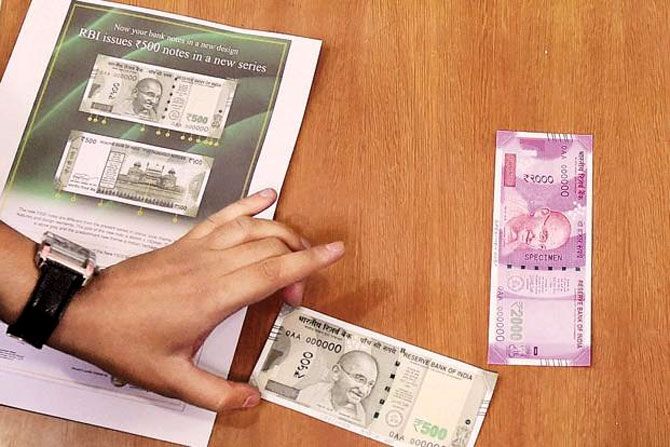Business Standard reporters piece together stories of how the new currency notes are being printed post-demonetisation at the
four presses -- Salboni (West Bengal), Dewas (Madhya Pradesh), Nashik (Maharashtra) and Mysuru (Karnataka).
In the first of a four-part series, Avishek Rakshit takes a look at how Salboni is working overtime to print currency notes.

IMAGE: Things are on a war footing inside the printing press. The machines are operating 24 hours a day, seven days a week. Photograph: PTI Photo.
Even as the news of demonetisation broke to the world late evening on November 8, the currency press at Salboni, in the West Midnapore district of West Bengal, had begun preparations to print new notes about two months prior to that.
Sources at the Salboni press, spread across 570 acres of land, told Business Standard that some time around September, employees were gearing up to print the new series of Rs 2,000 notes. But nobody in that press, which operates under Bharatiya Reserve Bank Note Mudran (BRBNMPL), a Reserve Bank of India subsidiary, had any inkling at that point that the government was about to ban all the big notes of the day.
The actual printing of Rs 2,000 notes, the most prevalent denomination in banks and automated teller machines after demonetisation, began early October in Salboni.
That was the time when instructions came from the authorities to step up printing of Rs 100 notes as well, people close to the scene of action said.
Soon, it was 24x7 activity, with employees working three shifts of eight hours each. Till then, there were only two shifts.
An employee recalled how he was taken by surprise when he heard Prime Minister Narendra Modi on November 8 announcing demonetisation. He could then piece together the unusual action in the currency press since September. The fear now was that workload would go up, as they would need to supply fast to the cash-starved banks and ATMs.
But, the authorities decided not to stress out the 1,000-odd permanent employees and around 450 casual staff any more, and the roster remained as it was in October.
If increasing the number of shifts and instructions to print new denomination were an indicator of things to come, so was the degree of security. Security at the printing press is always high, but it was beefed up manifold starting November, turning the Salboni facility into a fortress, said an insider.
While the press is located in a high-security zone, sharing a common wall with the specialised COBRA (Commando Battalion for Resolute Action) force’s training grounds, the number of Central Industrial Security Force inside the printing-cum-housing complex increased from 600 to some 900 personnel.
In addition, high-definition closed-circuit television cameras with night vision got installed at the entry points, recording all the movements through day and night. Even with the mandatory pink-coloured gate pass, one needs to go through the various checks to be able to enter the premises.
According to an employee, some 120 Indian Air Force servicemen were stationed in the premises last week on direct orders from the central government. “They are not directly involved in the printing process but are helping with packaging and logistics to ensure faster currency delivery,” he added.
That’s not the only change. The delivery pattern of the currency has altered too.
Previously, the newly printed currency used to be loaded onto train wagons, which entered the high-security cordoned area. Now, the new currency is being loaded into closed metal body and containerised trucks, escorted by armed personnel, and being sent to Kalaikunda Air Force Station in West Bengal. The currency is thereafter being sent to other cities only by air.
While the Salboni printing press has been focusing on printing Rs 2,000 and Rs 100 denomination banknotes for the past few weeks, one account suggested that printing of Rs 500 denomination notes had started as well.
However, the quality control division of the Salboni press is yet to receive the new Rs 500 banknotes. All currency needs to be first checked by the quality control cell before it can be despatched.
“It’s a war footing situation inside the printing press. The machines are operating 24 hours a day, seven days a week,” another employee said.
Workers estimate that on a daily basis, the press is printing at least five to seven million pieces of banknotes. Prior to October, the same press produced between an estimated two million and 4.5 million pieces.
The Salboni press is primarily relying on the paper shipped from the Bank Note Paper Mill in Mysuru, a joint collaboration of BRBNMPL and Security Printing and Minting Corporation of India, a government-owned corporation.
But, some of the paper as well as ink required to print the currency is met through imports. The current demand of currency paper is around 4,000 tonnes, of which 50 per cent is required to be imported. BRBNMPL, which operates the Salboni and Mysuru press, has a capacity to print 16 billion note pieces every year.
Beyond the printing press, known as Note Mudran Nagar, there’s life. The 570-acre premises houses staff quarters and facilities such as banks, post office, school, stores.
“We seldom need to go outside the premises as all daily needs are available here. It is only on Sundays and other holidays that we go out with family in the nearby town”, a permanent staff said.
But there’s some panic that there may not be much outing or socialising left in the days to come, as banks are running out of cash fast. Also, employees at Salboni are listening to tales coming from some other currency presses, which have implemented 12-hour long shifts already.
Part 2: Why notes ban is good news for people of this MP town
Part 3: India reeling under cash crunch, but this mint can't print Rs 2,000 notes











